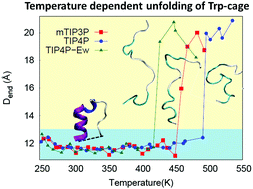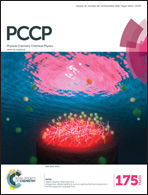Comparison of hydration behavior and conformational preferences of the Trp-cage mini-protein in different rigid-body water models†
Abstract
The secondary structure conformational properties and hydration shell metrics of the Trp-cage mini-protein are examined in the folded and unfolded ensembles in mTIP3P, TIP4P, and TIP4P-Ew water models with the CHARMM22 force-field using molecular dynamics simulations at 250 K. Upon changing the water model, the conformational order metrics of the peptide show significant differences in the unfolded rather than in the folded ensemble. The unfolding temperatures for Trp-cage are observed to be around 460, 470, and 430 K in mTIP3P, TIP4P, and TIP4P-Ew, respectively. Upon comparing the results with a previous study on a 16-residue β-hairpin fragment of the 2GB1 protein, the same set of conformational order metrics are found to be insufficient in describing the free energy landscape of peptides having a distinct native secondary structure. However, the hydration shell properties of the peptide have been found to be independent of the sequence of the peptide and it changes in conformation upon unfolding. Our calculations reveal that for a particular water model, the secondary structure preferences in the unfolded ensembles of the two peptides are qualitatively different. The unfolded structures of Trp-cage prefer extended and compact structures in TIP4P-Ew and mTIP3P water, respectively, whereas the β-hairpin peptide prefers extended unfolded structures in mTIP3P. The conformational preferences of the unfolded peptide in a given water model have been found to depend on the peptide sequence, where the binding energies of the water molecules around the polar residues in the unfolded conformations show sensitivity to the multipole moments of the water models. The significance of an accurate description of peptide–solvent interactions in the parametrization of biomolecular force-fields, to obtain an accurate description of conformational preferences, in particular in the unfolded ensembles of proteins, is highlighted.


 Please wait while we load your content...
Please wait while we load your content...